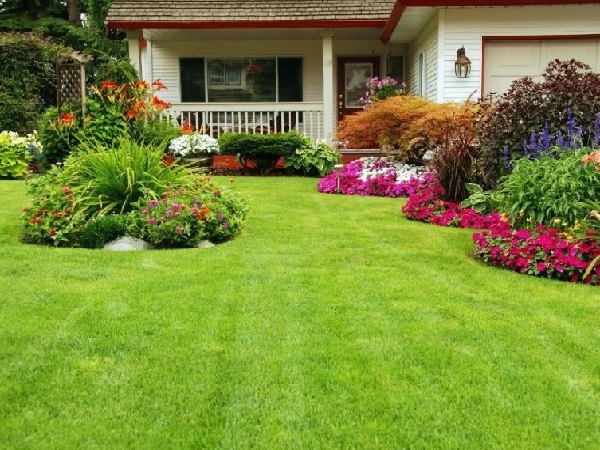Table of Contents
A lush and green lawn is a great way to add value to your home, create an inviting atmosphere for outdoor activities, and make your property the neighborhood star. But if you’ve ever had weeds in your yard, you would know how quickly they can turn that perfect oasis upside down.
Weeds can be a nuisance on any lawn, but they are more than just unsightly. They indicate that something is wrong with your turf and soil and can even spread diseases or pests to other plants. While it’s impossible to eliminate weeds from your lawn completely, there are steps you can take to control their growth and keep them from taking over.

Photo: Lawn
Here are eight tips for achieving a weed-free lawn:
1. Use a suitable herbicide
Herbicides are one of the go-to solutions to kill weeds, but it’s important to note that every type of weed requires a different kind of herbicide. Selective herbicides will target specific weeds while leaving other plants alone, and non-selective ones are those for total lawn control.
When applying a herbicide, read the label carefully and follow all safety instructions. You could also opt for convenience and hire lawn care experts in Omaha Nebraska to assist you in controlling this pesky weed growth in your lawn.
2. Mow regularly
Weeds are quick to take advantage of unkempt areas. This is why regular mowing is essential for keeping weeds at bay, as it prevents them from having the chance to get established and spread seeds. It also enforces good air circulation and sunlight, which can help maintain a weed-free lawn.
To prevent weeds from increasing, mow at a higher setting on your lawn mower. Aim for two to three inches of grass, and make sure to mow in all directions (not just straight lines) to distribute the blades evenly.
3. Practice proper fertilization
Poor soil health gives rise to unwanted weed growth. To give your grass the nutrients it needs to thrive and crowd out weeds, use a fertilizer specific to your grass type. Make sure to apply it according to package instructions, as over-fertilizing can cause as many problems as not applying enough.
If you choose an organic fertilizer, ensure it doesn’t contain any weed seeds or other materials that may cause problems down the line. Also, check with local ordinances about fertilizer use within city limits.
4. Water deeply and infrequently
Over-watering your yard will create a breeding ground for weeds. Instead of more frequent, short waterings, try deep but less regular sessions for a weed-free lawn. This encourages grass roots to grow deeper rather than just sitting on the surface and making it easier for weeds to take hold.
If you’re in a drought-prone area, consider investing in a smart irrigation system that adjusts according to climate and will alert you when there’s an issue with your watering schedule.
5. Aerate compacted soil
Foot traffic, mowing, heavy rains, and other activities can compact your soil over time. This creates a barrier between the grass and the essential nutrients for healthy growth. To prevent this, aerate by poking small holes in the soil to “breathe” new life into your lawn at least once a year.
You can manually accomplish this by poking your soil with a pitchfork or gardening fork. Or you can rent an aerator – mechanical plug or core aerator, for a more straightforward and thorough job.
6. Remove existing weeds
Weeds can spread rapidly, so removing them as soon as they appear is important. If you spot any weeds in your lawn, pull them up by hand or use a hoe or trowel to gently loosen the soil and extract the weed and its root system.
Be sure not to leave any bits of root behind, as these can still grow into new plants. Also, throw any of those you pull up in an area far away to maintain a weed-free lawn for a long time.
7. Overseed sparse areas
Thin grass areas allow weeds to move in and take over. One trick to prevent this is by overseeding your lawn with a grass seed blend compatible with the grass you already have.
Spread fresh seed in early spring and water the seeded areas regularly until new grass grows. Also, remember not to mow for at least a few weeks so that the new turf can get established. And, of course, use weed control products during this time as well.
8. Install a layer of mulch
Put a layer of organic mulch around the base of your plants and trees to create an extra barrier against weed growth. Mulching helps reduce weeds by blocking out sunlight and preventing weed seeds from reaching the soil.
Choose a wood-based mulch like cedar, cypress, or pine bark since they are organic and contain oils that repel bugs and diseases. Disperse the mulch evenly over your lawn at least 1″ thick for optimal results.
To sum it up
Tackling weeds can get tricky, and while you can do things to get rid of them, staying ahead is still the best way to keep a weed-free lawn! Develop a regular lawn care routine that includes mowing, watering, aerating, and fertilizing to keep your property healthy and strong. By taking these proactive steps, you’ll enjoy a healthy, lush, green yard all year round!
